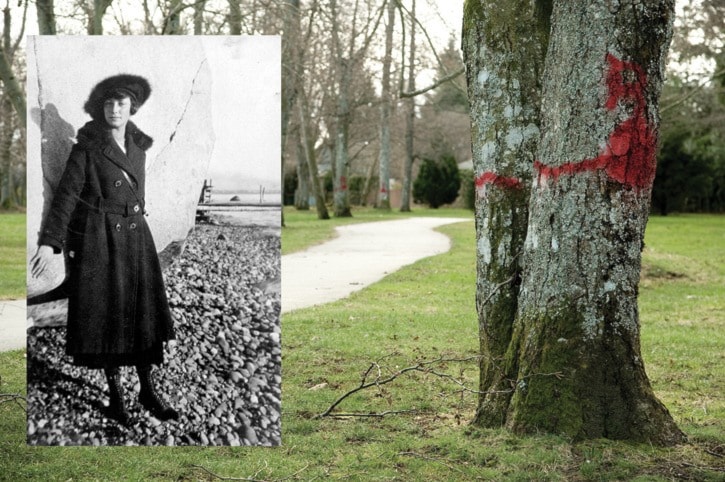With plans in the works for a makeover of Maccaud Park, it’s a good time to view the life of the woman who gave the park its name.
Irene Maccaud Nelson – Renee to her friends – was intelligent, ambitious, determined and forthright. She was quick to express her displeasure with any injustice, real or imagined.
In 1969, when she received notice she had failed her driver’s re-examination, she wrote back, “You can see by my record that I have never had in 51 years a serious car accident – nothing but a bump. Considering I can read the paper without glasses, I think it an imposition to require me to get glasses…”
(There are longtime White Rock residents who doubt glasses were the only requirement, recalling the manner in which she drove her distinctive 1949 Rover.)
Irene was not a conventional character at any stage of her life. According to the sworn statement of the attending doctor, she was named Irene Maud Beatrice at birth, but other documents – including her 1951 certificate of Canadian citizenship – record her as Irene Blanche.
She was born in 1897 to Francis William and Lucy Maccaud in Cortland, N.Y. Her father, born in Ireland of aristocratic French descent, was an Anglican minister. Her only sibling, brother Victor Emmanuel, was two years younger.
Early years were spent in the American Midwest, where Rev. Maccaud ministered to the Sioux in South Dakota. In 1904, they moved to the Pacific coast town of Blaine, Wash., where Irene caught her first glimpse of White Rock.
The family settled in Vancouver in 1912, where the children attended King Edward High School.
In 1932, she married Danish-born Walter Nelson, who had been married twice before, and was 14 years her senior. Irene soon took an active part in his Vancouver firm, Nelson Bottling Works, as well as supervising the renovation to apartments of the three large houses they purchased.
With childhood memories pulling her, Irene purchased her White Rock ‘farm,’ five acres bordering on the historic Semiahmoo Trail between North Bluff Road and Thrift Avenue, for $110 in 1935.
By the time Irene decided to make White Rock her permanent home in the mid-’50s, Walter had sold his business and was travelling in Europe for his health. He soon settled down in Denmark with Grete, who was to become his fourth wife.
Irene’s relationship with him remained amazingly amiable, even through divorce which Walter suggested for tax purposes. In 1959, he wrote, “I ask you to send me at once the divorce papers, and can’t you give us some idea when you expect to be here, my dear; we are longing after you… Grete sends love and I Renee dear send you as always my love.”
The subsequent financial settlement was considerably less amicable, the legal battle dragging on well into the ’60s. At the same time, Irene was embroiled in a battle over her father’s estate.
By now, Irene admitted to cash-flow problems. For years, she had been trying unsuccessfully to interest provincial and other cultural institutions in financing her home and collections.
Finally, in 1967, she appeared before White Rock city council, “regarding her property which she would like the city to buy for use as a public park, and which she regards as a historical site.”
The city purchased the Kent Street property – by then whittled down to 3.5 acres – for $48,000 the following year. Terms included life tenancy of her house for Irene.
It seemed a straightforward deal for the city, but when Irene died in 1978, serious problems arose.
When the city proposed to demolish the house, the local historical society challenged the decision, resulting in the formation of a fact-finding committee to determine the historical value of the building.
Research found very little remained of the original building, and no former owner named Larsen (the man rumoured to have used the house to shelter German spies smuggled into the United States during the First World War).
The house was razed in 1979, a year after Irene’s death.
A few more stories about Renee bear repeating.
A friend remembered visiting her one day and having to step over a log in Renee’s living room. One end was burning in the fireplace. As needed, Renee pushed the log further into the fire, explaining, “Beats chopping it up.”
To questions on a government form asking “(a) If you have children, state,” Renee answered, “None, thank God,” and “(b) The church where were you baptised,” replied, “Don’t know if I was baptised, and could care less.”
In 1971, she wrote, “It really is no laughing matter trying to organize a semblance of order among people who cannot grasp the urgency of doing something soon to preserve our natural environment. I’ve done my part severally: Maccaud Park, White Rock; a Gulf island (Rum Island which she ceded to British Columbia)…”
Undoubtedly, Irene would be pleased to know that the park she was so determined to preserve is still being enjoyed by the residents of White Rock.
The Peninsula’s best-known mother-and-son historians, Lorraine and Hugh Ellenwood, are dedicated to preserving history through the White Rock Museum & Archives. Call 604-541-2222, or email whiterockarchives@telus.net
